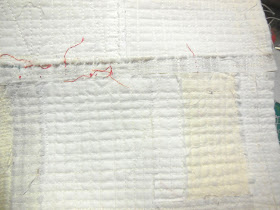The product police have several branches; besides the guys who keep track of products you love and take them out of production, there are some who keep track of products you love and introduce design flaws. I'm sorry to say that the second bunch have long been active with the bras that I have worn for a long time. (Male readers with delicate sensibilities might want to take a pass on the rest of this post.)
The bra straps on this model are made by folding some tricot knit around a base and fusing the edges together on the back side. Unfortunately, long before the bra is ready to be discarded, the fusing starts to come undone and the two halves ooze outward, exposing a line of scratchy used glue that does not feel nice against your shoulder.
I should point out that I am the descendant of the Princess known for her relationship with the Pea. I hate little external irregularities that impinge upon my perfect, sensitive body. I always cut out the labels from my clothing (irritating on the back of my neck), can't wear shoes with thread ends on the inside, can't sleep if there's a wrinkle in the mattress pad. So a line of scratchy stuff over my shoulder will drive me crazy. Over the years I have used various techniques to repair these straps by pulling the tricot edges back together, some involving hand sewing, others involving careful pinning and machine stitching.
A past repair
This week I took another culprit to my studio, resigned to spending a half hour fixing it. But inspiration struck. Why repair the strap when I could just turn it upside down? I cut the stitching that held the bra strap to the back of the bra, unthreaded the other end of the strap from its metal ring, turned the strap upside down, rethreaded it, and stitched it back to the bra the other way up. Total time, maybe five minutes, of which one was figuring out whether it would really work and one was rethreading the machine with the right color.
After: scratchy side up; beautiful side against my shoulder
Take that, product police!!


















































